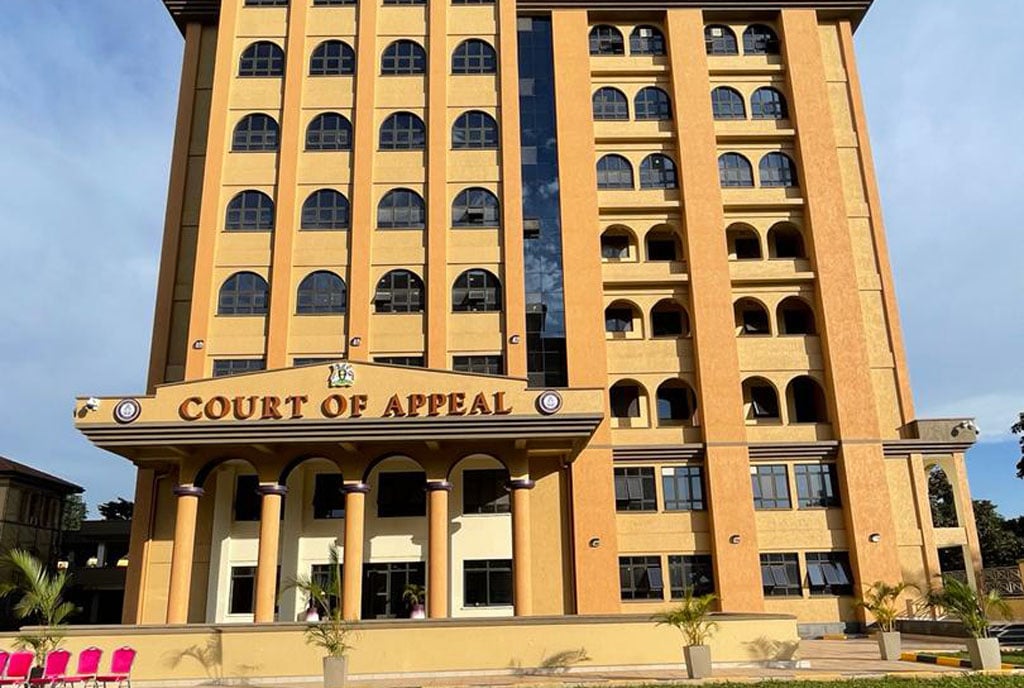Prime
Museveni lauds Judiciary for constructing court premises

President Museveni (in white) interacts with Judiciary Permanent Secretary Pius Bigirimana (left), Principal Judge Flavian Zeija (2nd left), Chief Justice Alfonse Owiny-Dollo (3rd left), Deputy Chief Justice Richard Buteera (2nd right) and Chief Registrar Sarah Langa during the commissioning of the twin tower buildings which will house the Court of Appeal and Supreme Court in Kampala on April 18, 2024. Photo/Abubaker Lubowa
What you need to know:
- The twin towers have a basement parking enough to accommodate 226 vehicles at a go, seven customised modern courtrooms and chambers for justices, four restaurants, gyms where the judges will exercise after work to keep healthy, childcare centres, a sauna, and two conference halls which can accommodate 500 guests, among other amenities.
President Museveni has applauded the Judiciary for constructing the twin towers, which will house the Supreme Court and Court of Appeal.
While officially commissioning the nine-storey towers in Kampala yesterday, Mr Museveni said: “I congratulate the Judiciary and the government of Uganda for funding and putting up these two towers here. As the speakers pointed out, this was all done using our money, it wasn’t a grant from some place or loan… no, it was the government of Uganda’s money.”
He added: “…Although the government provided the money, the initiative and the foresight were by the Judiciary. They are the ones who saw and mobilised the rest of us. So I salute the CJs (former Chief Justices) who were there, my schoolmate Bejamin Odoki, my young brother Bart Katureebe, and the current CJ (Alfonse Owiny-Dollo).”
Chief Justice Owiny-Dollo applauded Mr Museveni for “the unwavering support he has given to the Judiciary to realise the construction of the appellate courts”.
“It’s because of this and a lot more that I acknowledge with utmost appreciation, your Excellence undertaking and an unwavering commitment to provide a home for the two appellate courts,” he said.
He added: “I also seize this occasion to hail my predecessor Chief Justices Samuel Wako Wabuzi, Benjamin Odoki, and Bart Katureebe for their role in the pursuit of a home for each of the appellate courts. The cultivation of the seed and the tendering of the tree, whose fruits we are harvesting today, are directly attributed to each one of these eminent Judiciary administrators. It, therefore, is incumbent on us to reciprocate and ensure that justice seekers have meaningful access to justice.”
The head of the Judiciary also described yesterday’s commissioning of the facility as a historic milestone in the history of Uganda.
“All these courts beginning from 1967, had no home of their own…what we are saying your Excellence is, that for 57 years, the appellate courts have been wandering, homeless. I was about to say vagabonds, depending on private people to rent premises to them with court buildings,” the CJ said.
Judiciary Permanent Secretary Pius Bigirimana said at the start of the project, the estimated cost per square meter was $1,047 (Shs4m) but at the end of the construction, the actual cost per square metre is $975 (Shs3.7m).
He said this has saved the government close to Shs8.5b.
Mr Bigirimana applauded Chief Registrar Sarah Langa Siu, who he said was the chairperson Contracts Committee which ensured fairness and transparency during the sourcing of the contractor, Seyani Brothers.
Deputy Chief Justice Richard Buteera said his former office at Twed Towers was next to a bar and that with the new home, they are finally in a convenient place to conduct court business.
“The two towers now stand as beautiful towers in the middle of Kampala with a strategic view for our foreign visitors, local tourists, and our court users to appreciate the beauty of Kampala and the presence of the Judiciary in the City Centre. We shall forever be proud of ‘Our Twin Towers’,” Justice Buteera said.
ABOUT THE TWIN TOWERS
The twin towers have a basement parking enough to accommodate 226 vehicles at a go, seven customised modern courtrooms and chambers for justices, four restaurants, gyms where the judges will exercise after work to keep healthy, childcare centres, a sauna, and two conference halls which can accommodate 500 guests, among other amenities.
One of the Supreme Court halls is big enough to accommodate up to 150 court users. This is specifically designed for presidential election petitions given the large number of litigants that attend such sessions.




